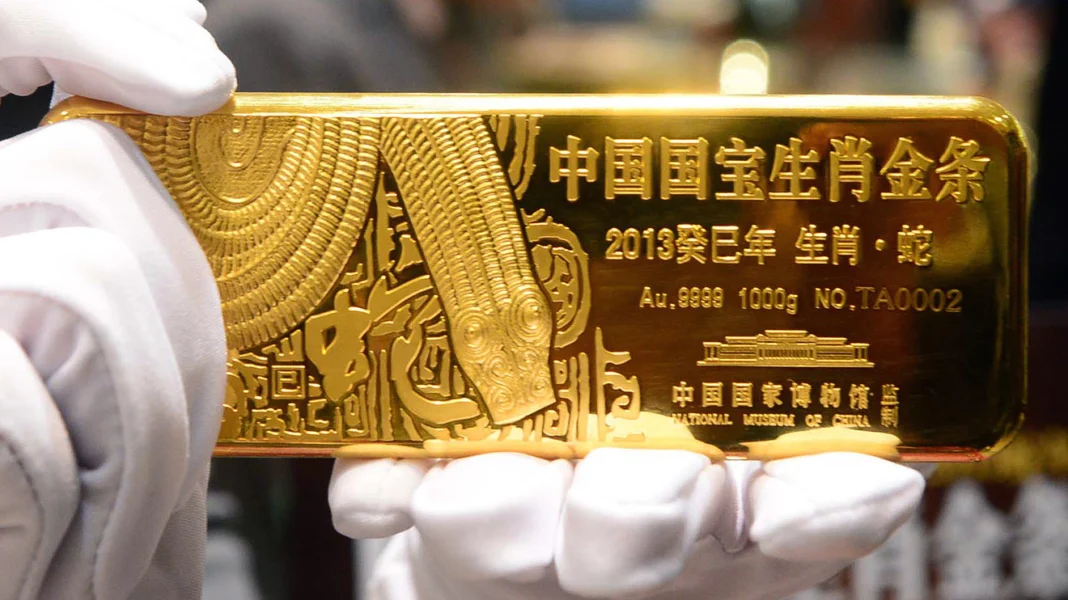A gold bar in China.
How much gold, exactly, does China hold? Well, it depends on who you ask – and no one quite knows the correct answer, except of course the powers-that-be in the Chinese Communist Party.
Experts such as Alastair McLeod and Francis Hunt have pointed out that China might have a significant amount of undeclared gold holdings that may completely topple the US-led global financial system of financial flows. The question however remains that if this estimation is true, why are the reserves still undisclosed and what does China aim by hiding the actual numbers? In order to understand that let’s first take a look at the various possible sources of the Chinese gold reserves and why it matters.
The Gold in China
Analyst Dominic Frisby notes that the actual statistics of the gold reserves in China could become the most significant story in the financial world and yet not much dialogue is happening around it. Rightly so, if these estimates are even a little bit close to being accurate, we need to pay attention. As of 2022, the latest declared Chinese gold holdings through the International Financial Statistics stand at 1,948 tonnes. This is just a miniscule portion of the total Chinese foreign exchange reserves, i.e. 3%. However, let us refrain from taking this figure at its face value and look at it from a different angle.
By 2017, China had officially surpassed South Africa to become the largest gold producer in the world.
How?
Gold mining. Now, China has produced over 15 per cent of the world’s gold in the past decade and this would definitely add to the total official Gold holdings in the country. To put this into context, China has mined around 6,830 tonnes of Gold since 2000 and this figure alone stands higher than the officially declared gold reserves. This makes more sense when we consider that this Gold is not exported and remains within the country. Moreover, China also engages in gold production internationally – it has bought assets in South Africa, Asia and South America and produced 15 per cent more gold internationally than through domestic production.
On top of this, China also imports gold from Switzerland and Dubai, the figures for which remain undeclared. However, the Gold imported from Hong Kong goes through the Shanghai Gold Exchange and hence we know that the imported Gold from Hong Kong stands at 6,700 tonnes since 2000. The World Gold Council also declared a figure of 2,500 tonnes of gold as privately held jewellery within China.
Why does it Matter?
This is an important question to answer. It has been an open secret in the international economic and political scenario that China and Russia are creating avenues to de-dollarize their economy. Conducting trade and financial transactions in their own official currencies is one way to do it. This is where the importance of the Chinese and even Russian gold reserves comes in. Analysts do believe that Russia like China might also have a stock of undeclared gold reserves and the Russian exclusion from the SWIFT financial system provides all the more incentive to reduce its dependence on the dollar.
Francis Hunt also suggests that when the time comes, the hidden gold reserves might act as a stabilising factor in protecting the Chinese economy while also developing an alternative financial system through the financial cooperation groupings like the BRICS (Brazil, Russia, India, China, South Africa). How this may play out in the near future, is for us to see. This is also the reason why Hunt believes that China may very soon declare the actual reserves of Gold holdings. While some analysts are of the view that China might still take its time to declare any official statistics. This brings us to the next important question – why is China hiding the real numbers?
Why is China being Discrete?
There are various aspects to consider while looking at this question. The first is, as has been noted by analysts like Ross Norman, 50 per cent of the Chinese gold is state owned. The rest are privately owned gold reserves or even owned by the Chinese army, the official figures for which are not declared. Apart from this, not all of the gold that enters into China goes through the Shanghai Gold Exchange (SGE). The People’s Bank of China does not trade through the SGE and so the gold bought by the central bank does not figure in the official SGE statistics. It is very important to consider that even if the Chinese State owns 50 per cent of the total gold reserves, it could officially stand at 15,000 tonnes – almost double the US gold reserves. However, this would be the case when and if China decides to declare the official status of the total holdings.
So why is China waiting? Dominic Frisby suggests that China would seek to wait before making such a huge declaration because it would create ripples across the global financial system. It could directly create a surge in the Chinese currency, yuan, while simultaneously devaluing the dollar holdings in foreign exchange reserves. One could argue that China would be waiting for the opportune moment.
Once declared, Chinese gold reserves would become a catalyst to the direct challenge to US financial hegemony and may even end up toppling it. Till then, let us wait and see how China chooses to navigate these numbers.

